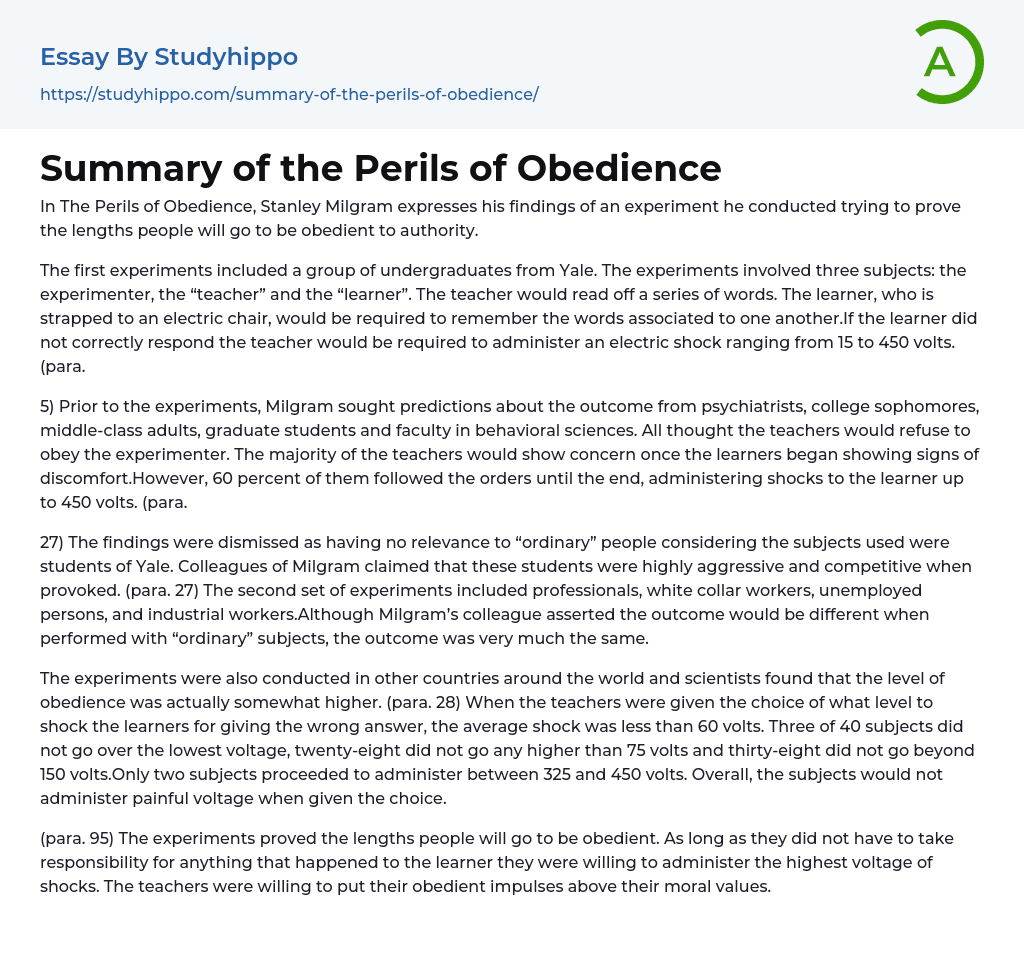In The Perils of Obedience, Stanley Milgram expresses his findings of an experiment he conducted trying to prove the lengths people will go to be obedient to authority.
The first experiments included a group of undergraduates from Yale. The experiments involved three subjects: the experimenter, the “teacher” and the “learner”. The teacher would read off a series of words. The learner, who is strapped to an electric chair, would be required to remember the words associated to one another.If the learner did not correctly respond the teacher would be required to administer an electric shock ranging from 15 to 450 volts. (para.
5) Prior to the experiments, Milgram sought predictions about the outcome from psychiatrists, college sophomores, middle-class adults, graduate students and faculty in behavioral sciences. All thought the teachers would refuse to obey the experimenter. The majority of the tea
...chers would show concern once the learners began showing signs of discomfort.However, 60 percent of them followed the orders until the end, administering shocks to the learner up to 450 volts. (para.
27) The findings were dismissed as having no relevance to “ordinary” people considering the subjects used were students of Yale. Colleagues of Milgram claimed that these students were highly aggressive and competitive when provoked. (para. 27) The second set of experiments included professionals, white collar workers, unemployed persons, and industrial workers.Although Milgram’s colleague asserted the outcome would be different when performed with “ordinary” subjects, the outcome was very much the same.
The experiments were also conducted in other countries around the world and scientists found that the level of obedience was actually somewhat higher. (para. 28) When the teachers were given the choic
of what level to shock the learners for giving the wrong answer, the average shock was less than 60 volts. Three of 40 subjects did not go over the lowest voltage, twenty-eight did not go any higher than 75 volts and thirty-eight did not go beyond 150 volts.Only two subjects proceeded to administer between 325 and 450 volts. Overall, the subjects would not administer painful voltage when given the choice.
(para. 95) The experiments proved the lengths people will go to be obedient. As long as they did not have to take responsibility for anything that happened to the learner they were willing to administer the highest voltage of shocks. The teachers were willing to put their obedient impulses above their moral values.
- Academia essays
- Higher Education essays
- Language Learning essays
- Studying Business essays
- Education System essays
- Study essays
- First Day of School essays
- Scholarship essays
- Pedagogy essays
- Curriculum essays
- Coursework essays
- Studying Abroad essays
- Philosophy of Education essays
- Purpose of Education essays
- Brainstorming essays
- Educational Goals essays
- Importance Of College Education essays
- Brown V Board of Education essays
- The Importance Of Higher Education essays
- Online Education Vs Traditional Education essays
- Academic And Career Goals essays
- Academic Integrity essays
- Brown Vs Board Of Education essays
- Distance learning essays
- Technology in Education essays
- Vocabulary essays
- Writing Experience essays
- Importance of Education essays
- Early Childhood Education essays
- Academic Degree essays
- Academic Dishonesty essays
- School Uniform essays
- Academic writing essays
- Cheating essays
- Bachelor's Degree essays
- MBA essays
- College Life essays
- Grade essays
- Diploma essays
- Phonology essays
- Sentence essays
- Filipino Language essays
- Pragmatics essays
- Millennium Development Goals essays
- History Of Education essays
- Graduate School essays
- Middle School essays
- School essays
- Special Education essays
- University essays




